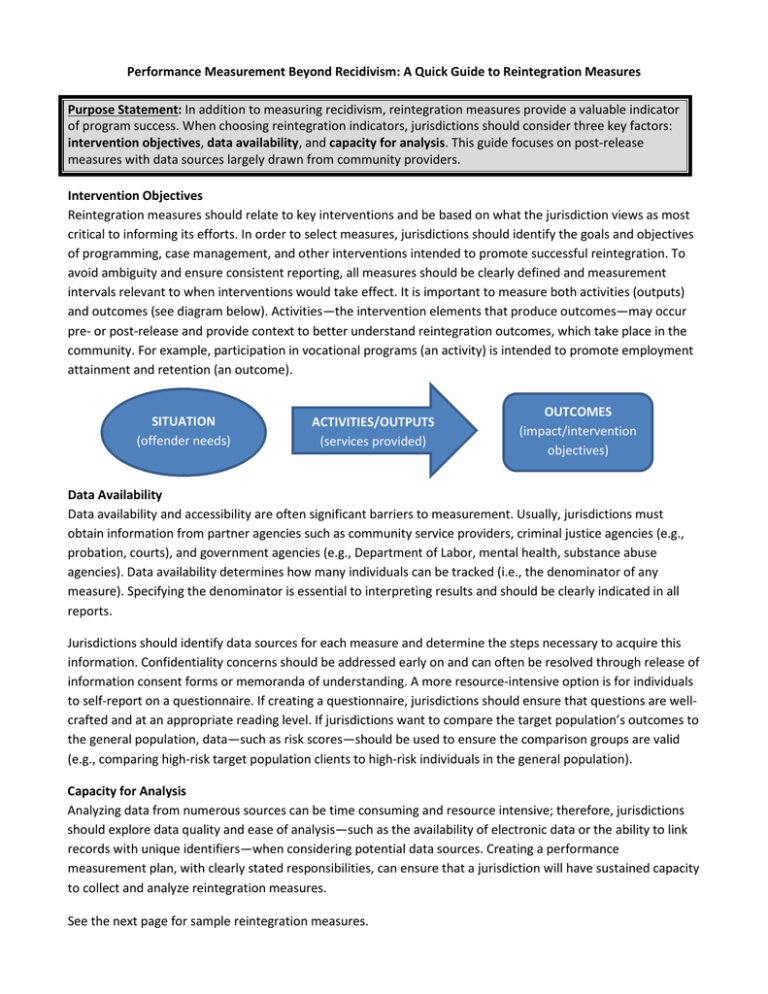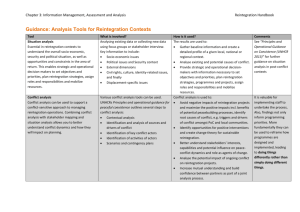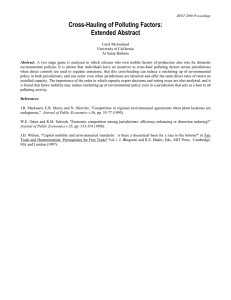Performance Measurement Beyond Recidivism: A Quick Guide to Reintegration Measures
advertisement

Performance Measurement Beyond Recidivism: A Quick Guide to Reintegration Measures Purpose Statement: In addition to measuring recidivism, reintegration measures provide a valuable indicator of program success. When choosing reintegration indicators, jurisdictions should consider three key factors: intervention objectives, data availability, and capacity for analysis. This guide focuses on post-release measures with data sources largely drawn from community providers. Intervention Objectives Reintegration measures should relate to key interventions and be based on what the jurisdiction views as most critical to informing its efforts. In order to select measures, jurisdictions should identify the goals and objectives of programming, case management, and other interventions intended to promote successful reintegration. To avoid ambiguity and ensure consistent reporting, all measures should be clearly defined and measurement intervals relevant to when interventions would take effect. It is important to measure both activities (outputs) and outcomes (see diagram below). Activities—the intervention elements that produce outcomes—may occur pre- or post-release and provide context to better understand reintegration outcomes, which take place in the community. For example, participation in vocational programs (an activity) is intended to promote employment attainment and retention (an outcome). SITUATION (offender needs) ACTIVITIES/OUTPUTS (services provided) OUTCOMES (impact/intervention objectives) Data Availability Data availability and accessibility are often significant barriers to measurement. Usually, jurisdictions must obtain information from partner agencies such as community service providers, criminal justice agencies (e.g., probation, courts), and government agencies (e.g., Department of Labor, mental health, substance abuse agencies). Data availability determines how many individuals can be tracked (i.e., the denominator of any measure). Specifying the denominator is essential to interpreting results and should be clearly indicated in all reports. Jurisdictions should identify data sources for each measure and determine the steps necessary to acquire this information. Confidentiality concerns should be addressed early on and can often be resolved through release of information consent forms or memoranda of understanding. A more resource-intensive option is for individuals to self-report on a questionnaire. If creating a questionnaire, jurisdictions should ensure that questions are wellcrafted and at an appropriate reading level. If jurisdictions want to compare the target population’s outcomes to the general population, data—such as risk scores—should be used to ensure the comparison groups are valid (e.g., comparing high-risk target population clients to high-risk individuals in the general population). Capacity for Analysis Analyzing data from numerous sources can be time consuming and resource intensive; therefore, jurisdictions should explore data quality and ease of analysis—such as the availability of electronic data or the ability to link records with unique identifiers—when considering potential data sources. Creating a performance measurement plan, with clearly stated responsibilities, can ensure that a jurisdiction will have sustained capacity to collect and analyze reintegration measures. See the next page for sample reintegration measures. Reintegration Area Reintegration Measures # and % of individuals provided job referrals # and % of individuals with resumes Employment: Attainment & Stability # and % of individuals released from jail with position of legal employment # and % of individuals with legal employment X months post-release # and % continuously employed over X months post-release # of jobs held over X months # and % of individuals released to a fixed address as part of release plan Housing: Attainment & Stability # and % of individuals obtaining or maintaining non-shelter housing among those in need of housing Average # of address changes over the course of a year # of shelter stays/nights on the street over X months post-release # and % earning GED Education Criminal Thinking Substance Abuse Health Mental Health Programs & Services (applicable to all program types) Other 1 # and % enrolled in secondary education: vocational education, community college, 4-year school # and % indicating reductions in criminal thinking (through scales such as the TCU Criminal Thinking Scale; would need to conduct pre- and post-release) Type activity activity activity or outcome 1 outcome outcome outcome activity or outcome outcome outcome outcome outcome activity or outcome outcome # and % of individuals with hospital stays due to drug or alcohol use # and % of individuals with positive urinalysis on probation # and % self-reporting substance abuse outcome outcome outcome # and % with a post-release health plan # and % with post-release health insurance # and % of individuals with at least one inpatient medical hospitalization/ER visit # of total hospitalization days Cost of total hospitalizations (can also calculate for other health-related indicators such as ER visits & ambulance uses) # and % of individuals accessing emergency medical care over X months postrelease activity outcome # and % self-reporting mental health disorders (e.g., depression) # and % of individuals for whom case managers report improved psychiatric and social functioning outcome # and % of individuals (with an identified need) referred for X program/service # and % of individuals enrolled in X program/service # and % of individuals engaged in X program/service activity activity activity activity or outcome activity # and % of individuals completing X program/service # and % of individuals paying child support payments/victim restitution outcome outcome outcome outcome outcome Some measures can be activities or outcomes, depending on program components and objectives. For example, an employment program that places individuals in jobs may define job placement as an activity and job retention as an outcome. Other employment programs that prepare individuals for employment could define employment attainment as an outcome.




